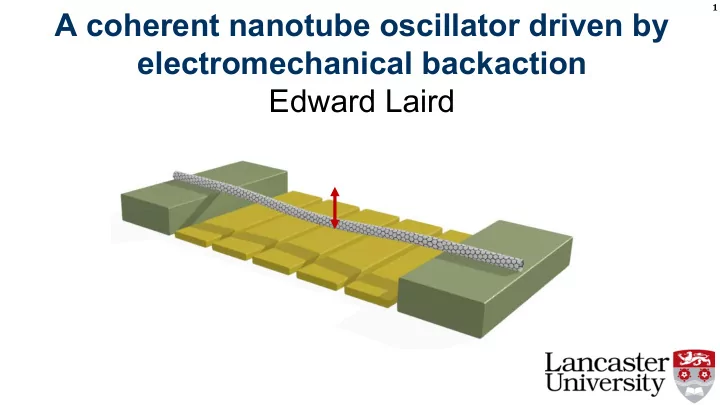

1 A coherent nanotube oscillator driven by electromechanical backaction Edward Laird
A coherent nanotube oscillator driven by electromechanical backaction Yutian Wen Natalia Ares Tian Pei Felix Schupp Andrew Briggs (at Oxford) European Microkelvin Platform 2 –
The limits of displacement sensing Suspended carbon nanotube ~10 6 nucleons Diameter ~5 nm Length ~800 nm • High mechanical quality factor • High frequency (200 MHz ≡ 10 mK) • Mechanically compliant • Can be integrated into electronic circuits 3
The limits of displacement sensing: Magnetic resonance microscopy Force per proton: ~10 -20 N Review: Poggio & Harzheim (2018) 4
A coherent nanotube oscillator driven by electromechanical backaction 1. Measuring vibrations with a single-electron transistor 2. Creating a nanomechanical oscillator 3. Characterizing the oscillator 5
Question 1: How precisely can we measure nanomechanical vibrations? Standard quantum limit for continuous measurements (m/√Hz): Quality factor Mechanical frequency Mass Theory: Caves et al. (RMP 1982) Experiment: LaHaye et al. (Science 2004) Review: Clerk et al. (RMP 2010) 6
Question 2: Can we make a laser for sound? Microwave amplification by stimulated emission of radiation (Townes, 1955) 7
A vibrating carbon nanotube device Laird et al (2011) ~2 nm 1 µm 8
The single-electron transistor Energy levels Current (nA) Gate voltage (V) Hüttel et al (van der Zant group, 2009) 9
Sensing vibrations Motion Current Displacement Hüttel et al (2009) 10
Fast readout for nanotube vibrations SiGe amplifier Details: Wen et al. (2018) Schupp et al. (2018) 11
How precisely can we measure nanomechanical vibrations? 12
Is this a laser analogue? 13
Evidence for self-driven oscillations sd D I 5 Current (nA) Gate voltage -4.93 V g 5 5 Self-oscillation threshold 0 Gate voltage From Steele et al (Kouwenhoven group, 2009) 14
A coherent nanotube oscillator driven by electromechanical backaction 1. Measuring vibrations with a single-electron transistor 2. Creating a nanomechanical oscillator 3. Characterizing the oscillator 15
Excitation off Bias on, excitation on Gate voltage (mV) Bias on, excitation off
A coherent nanotube oscillator driven by electromechanical backaction 1. Measuring vibrations with a single-electron transistor 2. Creating a nanomechanical oscillator 3. Characterizing the oscillator 17
Measuring the output coherence 18
Statistics of the output coherence Emission histograms Correlation function 19
How the oscillator works Electrical charge Electrical charge Bennet & Clerk (2007) Usmani, Blanter, Nazarov (2007) 20
How the oscillator works Electrical charge Bennet & Clerk (2007) Usmani, Blanter, Nazarov (2007) 21
Laser physics I: Injection locking Implementation Principle Discovery: Huygens (1666) In lasers: Stover and Steier (1966) 22
Laser physics I: Injection locking 23
Laser physics II: Stabilising using feedback 24
Laser physics II: Stabilising using feedback 25
Why are nanomechanical lasers interesting? • They connect the physics of backaction with the physics of lasers. • They are amplifiers and transducers. Narrow linewidth means better sensitivity to perturbations. • They are on-chip phonon generators for microscopy, information transfer, etc. • They couple charge and motion on a mesoscopic scale. 26
Other nano-oscillators Electrical Spin transfer torque Josephson laser Double quantum dot micromaser (Pribiag 2007) (Liu 2017) (Cassidy 2017) Mechanical Optomechanics Optomechanics Vibrating SQUID (Grudinin 2010) (Beardsley 2010) (Etaki 2013) 27
Summary Quadrature Maser signal Classical coherence In-phase signal Injection locking Emission Nanotube oscillator Frequency Feedback stabilisation Emission Frequency Ares et al. PRL 2016 117 170801 (2016) Wen et al. APL 113 153101 (2018) Schupp et al. arXiv:1810.05767 (2018) Wen et al. arXiv:1903.04474 (2019) 28
Recommend
More recommend